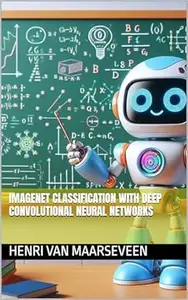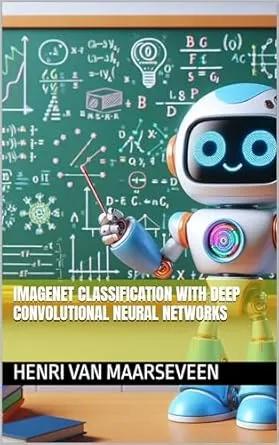ImageNet Classification with Deep Convolutional Neural Networks
English | May 29, 2024 | ASIN: B0D5LQ9ZM8 | 58 pages | Epub | 1.07 MB
English | May 29, 2024 | ASIN: B0D5LQ9ZM8 | 58 pages | Epub | 1.07 MB
Introduction to Deep Learning and Convolutional Neural Networks (CNNs)
Overview of Deep Learning
Deep learning, a subset of machine learning, has revolutionized the field of artificial intelligence (AI) by enabling computers to learn from vast amounts of data. Unlike traditional machine learning models, which often require manual feature extraction, deep learning models can automatically discover intricate patterns in raw data through hierarchical feature learning. This capability has made deep learning particularly effective in areas such as image and speech recognition, natural language processing, and more.
Key Concepts in Deep Learning:
Neural Networks: At the core of deep learning are neural networks, which are composed of layers of interconnected nodes (neurons). These networks are inspired by the human brain's structure and function.
Deep Neural Networks (DNNs): When neural networks have multiple layers (known as hidden layers), they are referred to as deep neural networks. These additional layers allow the network to learn more complex representations of the data.
Training: Deep learning models are trained using large datasets and optimization techniques. Training involves adjusting the weights of the network to minimize the difference between the predicted outputs and the actual outputs.
Basics of Convolutional Neural Networks (CNNs)
Convolutional Neural Networks (CNNs) are a specific type of neural network designed to process data with a grid-like topology, such as images. CNNs have become the cornerstone of modern computer vision applications due to their ability to capture spatial hierarchies in data.
Key Components of CNNs:
Convolutional Layers: These layers apply convolution operations to the input data, using filters to detect local patterns such as edges, textures, and shapes. Each filter produces a feature map, highlighting specific features in the input.
Pooling Layers: Pooling layers downsample the feature maps, reducing their dimensions and making the model invariant to small translations in the input. Common pooling operations include max pooling and average pooling.
Fully Connected Layers: These layers are similar to those in traditional neural networks, where each neuron is connected to every neuron in the previous layer. They are used for high-level reasoning and classification tasks.
Advantages of CNNs:
Parameter Sharing: Convolutional layers use shared weights (filters), significantly reducing the number of parameters compared to fully connected layers.
Local Connectivity: By focusing on local connections, CNNs can effectively capture spatial hierarchies and dependencies in the data.
Implications and Impact:
Breakthrough Performance: AlexNet's success in the ImageNet competition demonstrated the potential of deep CNNs for large-scale image classification tasks. This breakthrough performance spurred widespread interest and investment in deep learning research.
Foundation for Modern AI: The techniques and architectures introduced in the paper laid the groundwork for subsequent advancements in AI, influencing the development of more sophisticated models like VGG, ResNet, and beyond.
OpenAI's Development: OpenAI has built on the principles and techniques introduced by AlexNet to develop state-of-the-art AI systems. By incorporating deep learning and CNNs, OpenAI has achieved significant breakthroughs in various AI domains, including natural language processing, reinforcement learning, and more.



